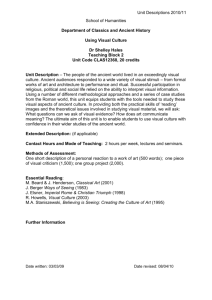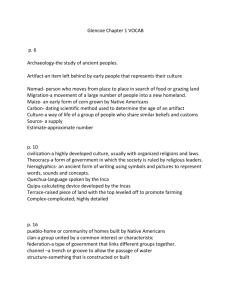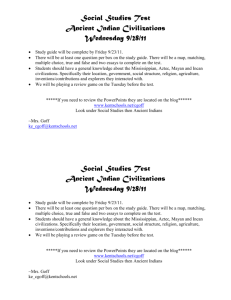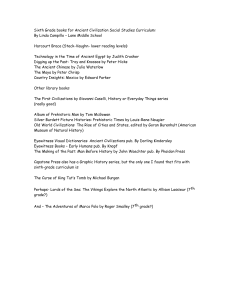history
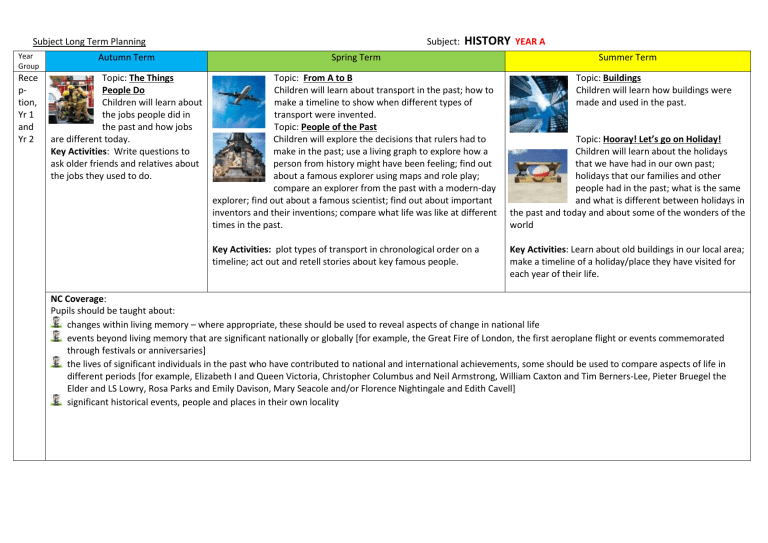
Subject Long Term Planning
Year
Group
Rece p- tion,
Yr 1 and
Yr 2
Autumn Term
Topic: The Things
People Do
Children will learn about the jobs people did in the past and how jobs are different today.
Key Activities: Write questions to ask older friends and relatives about the jobs they used to do.
Spring Term
Subject:
HISTORY
YEAR A
Topic: From A to B
Children will learn about transport in the past; how to make a timeline to show when different types of transport were invented.
Topic: People of the Past
Children will explore the decisions that rulers had to make in the past; use a living graph to explore how a person from history might have been feeling; find out about a famous explorer using maps and role play; compare an explorer from the past with a modern-day explorer; find out about a famous scientist; find out about important inventors and their inventions; compare what life was like at different times in the past.
Key Activities: plot types of transport in chronological order on a timeline; act out and retell stories about key famous people.
Summer Term
Topic: Buildings
Children will learn how buildings were made and used in the past.
Topic: Hooray! Let’s go on Holiday!
Children will learn about the holidays that we have had in our own past; holidays that our families and other people had in the past; what is the same and what is different between holidays in the past and today and about some of the wonders of the world
Key Activities: Learn about old buildings in our local area; make a timeline of a holiday/place they have visited for each year of their life.
NC Coverage:
Pupils should be taught about: changes within living memory – where appropriate, these should be used to reveal aspects of change in national life events beyond living memory that are significant nationally or globally [for example, the Great Fire of London, the first aeroplane flight or events commemorated through festivals or anniversaries] the lives of significant individuals in the past who have contributed to national and international achievements, some should be used to compare aspects of life in different periods [for example, Elizabeth I and Queen Victoria, Christopher Columbus and Neil Armstrong, William Caxton and Tim Berners-Lee, Pieter Bruegel the
Elder and LS Lowry, Rosa Parks and Emily Davison, Mary Seacole and/or Florence Nightingale and Edith Cavell] significant historical events, people and places in their own locality
Yr 3 and
Yr 4
Topic: Scavengers and Settlers
Children will find out how fossils are made and what we can learn from them; find out about our earliest ancestors; explore the skills our ancestors needed to survive; use evidence to find out about a prehistoric hunter; find out about a river valley civilisation; find out about a Stone Age village; find out about Bronze and Iron Age cultures.
Key Activities: make their own fossils; study the skeleton and artefacts of a Stone Age hunter.
NC Coverage:
Changes in Britain from the Stone Age to the Iron Age. Including: late Neolithic hunter-gatherers and early farmers, for example, Skara Brae
Bronze Age religion, technology and travel, for example, Stonehenge
Iron Age hill forts: tribal kingdoms, farming, art and culture
Yr 5 and
Yr 6
Topic: The great, the bold, the brave
Children will find out about the Greek city-states of Athens and Sparta and explore their political; Find out about the Persian Wars and their impact on
Greece; Learn about Athenian life by studying the
Parthenon; Find out about the origins of the
Olympic Games; find out about Alexander the
Great; Discover why Rome had a republic and then an emperor; Find out about daily life in Ancient
Rome; Explore the impact of Roman invasion on another country; Understand the cause and effect of the fall of the Roman Empire; Learn about people and culture through archaeological evidence
Key Activities: Make models of some of the famous and most celebrated buildings from
Ancient Greece and Ancient Rome; Plan and perform our own Greek play
Topic: Time Tunnel
Children will find out how historical time can be recorded and measured; how we can sort, sequence and order the past; how we can interpret events to explore the attitudes of people in the past; What happened at different times in different cultures
Key Activities: Research their own family tree; work in groups to research and produce a timeline for a key past civilisation
NC Coverage:
Children should be taught about: the Roman Empire and its impact on Britain the achievements of the earliest civilizations – an overview of where and when the first civilizations appeared and a depth study of one of the following: Ancient
Sumer, The Indus Valley, Ancient Egypt, The Shang Dynasty of Ancient China
Ancient Greece – a study of Greek life and achievements and their influence on the western world a non-European society that provides contrasts with British history – one study chosen from: early Islamic civilization, including a study of Baghdad c. AD 900;
Mayan civilization c. AD 900; Benin (West Africa) c. AD 900-1300
Subject Long Term Planning
Year Group
Reception,
Year 1 and
Year 2
Autumn Term
Topic: How are you?
Children will find out about the doctors who discovered medicines and about diseases from the past.
Key Activities: Read, tell and act out stories about famous doctors such as
Edward Jenner or Jonas Salk.
Topic: The Magic
Toymaker
Children will find out about toys and games from the past; how to decide if a toy is new or old; how to create our own toy museum; how we can learn about the past in different ways
Key Activities: interview a parent/grandparent about a favourite childhood toy
Subject:
HISTORY
YEAR B
Spring Term
Topic: Time Travellers
Children will find out how to create a timeline; find out about events that are important to them; use objects to find out more about an event; learn about important events that happened in our local area; learn about an event by interviewing someone who was there; use different sources to learn about a national event; explore events of global significance by asking and answering questions
Key Activities: organise pictures of key events on a physical timeline
Topic: The Circus is Coming to
Town
Children will find out what circuses were like in the past; about some of the people who made circuses famous and how circuses have changed over the years
Key Activities: draw or write about the circus in
Roman times
Summer Term
NC Coverage:
Children should be taught about: changes within living memory. Where appropriate, these should be used to reveal aspects of change in national life events beyond living memory that are significant nationally or globally [for example, the Great Fire of London, the first aeroplane flight or events commemorated through festivals or anniversaries] the lives of significant individuals in the past who have contributed to national and international achievements. Some should be used to compare aspects of life in different periods [for example, Elizabeth I and Queen Victoria, Christopher Columbus and Neil Armstrong, William Caxton and Tim
Berners-Lee, Pieter Bruegel the Elder and LS Lowry, Rosa Parks and Emily Davison, Mary Seacole and/or Florence Nightingale and Edith Cavell] significant historical events, people and places in their own locality
Year 3 and
Year 4
Topic: Temples, Tombs and Treasures
Children will find out about the importance of rivers to ancient civilisations; find out about the daily life of Ancient Egyptians; learn how to write using Egyptian hieroglyphics; find out about the different rulers of Egypt; find out about
Ancient Egyptian religion and burials; explore how the pyramids were built; find out about the discovery of
Tutankhamun’s tomb; use sources to find out about Ancient Sumer; compare life in Ancient Sumer with life in Ancient
Egypt
Key Activities: make own papyrus and write in hieroglyphics; write or video instructions on how to embalm a body
Topic: Treasure
Children will find out how artefacts can help us find out about the past; how we can use fact and opinion to create a profile about a historical person; about different historical sources; about famous archaeologists
Key Activities: write a profile of a person based on finding and opening a mysterious suitcase
NC Coverage:
Children should be taught about: the achievements of the earliest civilizations – an overview of where and when the first civilizations appeared and a depth study of one of the following: Ancient Sumer; The Indus Valley; Ancient Egypt; The Shang Dynasty of Ancient China
Year 5 and
Year 6
Topic: AD 900
Children will find out about the Mayans from the buildings and artefacts they left behind; explore the religious beliefs of the Mayans; find out about Mayan writing, numbers and their calendar system; examine the reasons why the Mayan empire declined; create a map of Benin city in
West Africa; use sources to find out about the Kingdom of Benin; explore the religious beliefs and festivals of the
Edo/Benin people; find out what happened to the Kingdom of Benin; learn about Mohammad and the Islamic civilization; find out about the wonders and achievements of the Golden Age of
Islam; understand the reasons for the fall of the Islamic empire
Key Activities: Research one of a selection of Mayan cities and decide their own method of presenting the information
Topic: Champions for
Change
Children will find out about the origins of democracy; how and why empires have been established and about a historical campaign or revolution for change
Key Activities: compare Ancient Greek democracy with its modern day equivalent
Topic: Mission to Mars
Children will find out about what people in the past used to think about Mars and about the evidence to prove and disprove intelligent life on Mars
Topic: Building a Village
Children will find out about the history of our local area; about the history of two settlements from the host and home countries; how to use evidence to research and record history; how to create a settlements museum
Key Activities: produce an illustrated timeline of Mars
Missions; research the history of Bramford
Geographical skills and fieldwork use maps, atlases, globes and digital/computer mapping to locate countries and describe features studied use the 8 points of a compass, 4- and 6-figure grid references, symbols and key (including the use of Ordnance Survey maps) to build their knowledge of the United
Kingdom and the wider world use fieldwork to observe, measure record and present the human and physical features in the local area using a range of methods, including sketch maps, plans and graphs, and digital technologies



